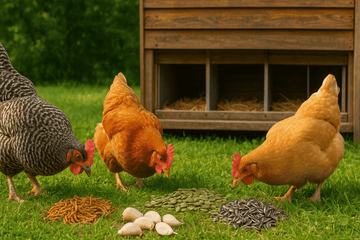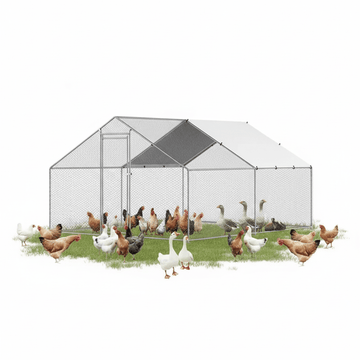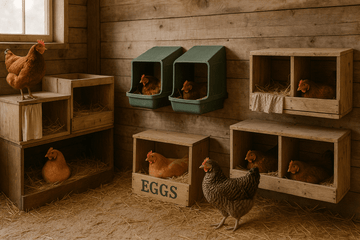Raising healthy chickens that lay high-quality eggs isn’t just about giving them a cozy coop—it’s about what you put in their feed bowls, too. Just like humans, chickens need a balanced diet to function at their best. While most backyard chicken keepers rely on standard layer feed, the real secret to richer yolks, stronger shells, and more consistent laying might be hiding in your pantry or garden.
This guide covers seven powerful yet surprising foods that can dramatically enhance egg production and quality. Each of these additions is backed by nutritional science and trusted by experienced poultry keepers. Let’s break down the benefits, and how you can start feeding your flock for better eggs—starting today.
For even better results in egg production, it's essential to pair a nutritious diet with comfortable, secure nesting spaces. If you're looking to upgrade your setup, check out our curated rollaway nest box. Designed for durability, hygiene, and hen comfort, these nesting solutions help ensure every egg is laid in the best possible environment.
Why Diet Matters for Egg Quality
Nutritional Needs of Laying Hens
Laying hens have specific dietary requirements to produce eggs consistently and maintain their own health. They need a careful balance of proteins, vitamins, minerals, and fats. Protein supports egg formation, calcium strengthens eggshells, and vitamins like A, D, and E contribute to reproductive health and yolk vibrancy.
Many commercial layer feeds attempt to cover these bases, but they can fall short, especially if your hens are free-ranging or you’re mixing your own feed. Even slight deficiencies can result in soft shells, irregular laying, or pale yolks. Supplementing their diet with strategic, nutrient-rich foods bridges the gap.
It’s not just about quantity—it’s quality, too. Feeding your hens a nutrient-dense diet improves not only how often they lay but also the nutritional content and appearance of each egg.
Common Deficiencies That Affect Eggs
One of the biggest culprits of poor egg quality is calcium deficiency. It leads to thin shells or shell-less eggs. Protein deficiency, on the other hand, can slow down or halt production altogether. Lack of certain vitamins can dull yolk color, reduce fertility, and cause lethargy in hens.
What’s surprising is that these issues often occur even in flocks that appear healthy and active. That’s why adding nutrient-packed foods is essential—it gives your hens a natural edge without synthetic supplements.
The Link Between Nutrition and Eggshell Strength
Calcium and Mineral Importance
Calcium is the cornerstone of a strong eggshell. Without it, your hens will pull calcium from their own bones, which can lead to long-term health issues. While oyster shells and limestone are common calcium supplements, many natural foods also offer excellent sources of calcium and trace minerals that are more bioavailable.
Foods like dark leafy greens, alfalfa, and even sesame seeds are packed with calcium and magnesium, which work together to improve shell integrity and prevent deformities.
Role of Protein and Amino Acids
Proteins are vital for forming not just the egg white (albumen), but also for overall hormone function and feather health. High-protein treats like mealworms and sunflower seeds provide essential amino acids that commercial feeds might lack. These amino acids, especially methionine and lysine, are crucial for optimal egg formation.
Feeding your hens protein-rich foods at the right stages (like during molting or post-laying stress) ensures better egg output and helps with faster recovery.
Food #1: Pumpkin Seeds
Natural Protein and Parasite Control
Pumpkin seeds, also known as pepitas, are more than just seasonal snacks. They’re packed with protein, healthy fats, and cucurbitacin—a compound believed to help paralyze and expel intestinal parasites in chickens. This natural deworming effect can improve gut health, which directly impacts nutrient absorption and egg production.
In addition, the high zinc content supports reproductive function, while the seeds' protein content aids in maintaining healthy laying cycles.
Boosting Yolk Color and Immunity
Pumpkin seeds are rich in antioxidants and beta-carotene, which enhance yolk color and boost the immune system. Adding crushed or ground pumpkin seeds to your flock’s feed a couple of times a week can offer long-term benefits. Just be sure to offer them raw and unsalted to avoid unnecessary additives.
Not only are you improving your hens’ health, but you’re also enriching the eggs with deeper, more golden yolks—just what most backyard keepers love to see.
Food #2: Oregano
Antibacterial Properties
Oregano isn’t just a tasty herb—it’s a powerful natural antibiotic. It contains thymol and carvacrol, compounds known for their antimicrobial effects. Feeding oregano to your chickens helps combat respiratory infections, digestive issues, and general illness without resorting to commercial medications.
When your flock is healthy, they can allocate more energy to egg production instead of fighting off infections. This results in more consistent laying and stronger, more resilient birds.
Immune Boost and Respiratory Health
Fresh oregano, dried flakes, or oregano essential oil (diluted properly) can be added to your hens’ feed or water. A few sprigs of fresh oregano in the nesting boxes also act as a natural insect repellent and calming agent.
Oregano improves circulation, boosts immunity, and helps reduce inflammation—all of which are crucial for active laying and flock vitality. Many poultry farmers swear by oregano as their secret to fewer vet visits and better overall egg quality.
Food #3: Sunflower Seeds
Healthy Fats for Glossy Feathers and Egg Quality
Sunflower seeds—especially black oil sunflower seeds (BOSS)—are a powerhouse of healthy fats and essential nutrients. They’re packed with monounsaturated and polyunsaturated fats that not only support hens’ overall health but also enhance the nutritional content of the eggs they lay.
These fats contribute to the development of thicker egg whites, firmer yolks, and eggs that stay fresher for longer. Additionally, the high-fat content provides extra energy for hens, particularly during colder months when energy needs increase to maintain body heat and production levels.
Feathers are also a great health indicator in hens. The natural oils in sunflower seeds help produce shinier, fuller plumage, which is often a sign of a healthy, productive bird.
Source of Vitamin E and Protein
Vitamin E, abundant in sunflower seeds, plays a vital role in reproductive health, aiding in the development of follicles and supporting egg-laying hormones. The seeds are also rich in protein, adding a crucial supplement to the hen’s diet that enhances egg production frequency and quality.
Feed these seeds in moderation—too many can lead to weight gain or an unbalanced diet. A handful mixed into feed or scattered as a scratch treat 2–3 times per week is sufficient to deliver the benefits without overdoing it.
Food #4: Flaxseeds
Omega-3 Boost for Healthier Eggs
Flaxseeds are an excellent source of omega-3 fatty acids, which translate directly into eggs that are higher in these heart-healthy fats. Many consumers seek omega-3-enriched eggs for their health benefits, and feeding flaxseed is one natural way to produce them right in your backyard.
These fatty acids also help reduce inflammation in hens, promote brain and nerve function, and support cardiovascular health—critical for high-producing layers.
Crushed flaxseed (not whole, which can pass undigested) is the best way to ensure absorption. A tablespoon mixed into feed per hen, two or three times a week, is a solid starting point.
Improved Shell and Nutrient Profile
In addition to omega-3s, flaxseeds offer a decent punch of magnesium, manganese, and B vitamins—all important for strong shells and consistent laying. They also contain phytoestrogens, plant-based compounds that can gently support reproductive hormones.
By introducing flaxseeds to your hens’ diet, you’re not just improving egg quality—you’re elevating the nutritional profile of every egg they produce. It’s a win-win for your flock and your breakfast plate.
Food #5: Garlic
Natural Antibiotic and Detoxifier
Garlic is like a superfood for chickens. It acts as a natural antibiotic, helping to ward off bacterial infections and parasites while boosting your flock’s immune response. Allicin, the active compound in garlic, provides antimicrobial benefits that keep respiratory and digestive systems in top shape.
When your chickens are healthy, they put more energy into laying eggs rather than fighting off illness. This means more eggs, with higher consistency and quality.
Crushed raw garlic can be mixed into feed or added to water (in moderation—about one clove per gallon of water) as a natural tonic. It’s also effective in detoxifying the blood and keeping internal systems clean.
Enhances Overall Flock Health
Beyond egg production, garlic contributes to better feather condition, improved appetite, and even a reduction in external parasites like lice and mites. A healthy hen is a productive hen—and garlic plays a quiet but powerful role in sustaining that health.
Just be cautious not to overdo it. While garlic is incredibly beneficial, too much can affect egg taste or digestive balance. Stick to weekly or bi-weekly doses and monitor how your flock responds.
Food #6: Alfalfa
Rich in Vitamins A, D, E, and K
Alfalfa is more than livestock fodder—it’s a nutritional powerhouse. Packed with vitamins A, D, E, and K, it helps support a hen’s immune system, bone strength, and reproductive health. These vitamins are vital for producing vibrant, healthy eggs with strong shells and deep-colored yolks.
You can offer alfalfa in pellet form, chopped hay, or fresh if you grow it yourself. It’s particularly helpful during winter months when fresh greens are limited.
Alfalfa is also a natural source of phytoestrogens, which can help regulate laying patterns and reduce dips in production during seasonal changes.
Supports Yolk Color and Laying Consistency
Alfalfa’s chlorophyll and carotenoid content enhance yolk pigmentation, giving you those rich, golden-orange yolks that backyard keepers and buyers alike love. It also provides slow-release protein and fiber that supports digestion and sustained energy.
Many chicken keepers report more consistent laying and brighter, better-formed eggs when alfalfa is part of the regular feed rotation. Consider it a steady workhorse in your flock’s diet.
Food #7: Mealworms
High-Protein Powerhouse
Mealworms are hands-down one of the best natural protein sources you can offer your hens. Whether dried or live, these wiggly treats are packed with essential amino acids that are critical for egg formation, muscle development, and feather regrowth—especially during molting.
Just a small handful of mealworms can deliver a serious nutritional boost. Hens love them, making mealworms a perfect training tool, too. They stimulate natural foraging behavior and help maintain healthy weight and energy levels during stressful periods.
Protein levels in mealworms are typically around 50%, making them more concentrated than most commercial feeds. That’s a huge help when you’re aiming for consistent laying and larger, healthier eggs.
Encourages Consistent Egg Production
Mealworms can jumpstart production if your hens have slowed down due to stress, molting, or dietary gaps. Feeding them 2–3 times a week is a good rhythm to provide support without overloading the diet.
For best results, mix dried mealworms into feed, offer them separately as treats, or scatter them to encourage movement and pecking behavior. They also pair well with other feeds, such as oats or cracked corn, for a balanced supplement.
High-protein treats like this should complement—not replace—your core feed, but they’re one of the best additions to keep your flock productive and your egg basket full.
How to Safely Introduce New Foods to Your Flock
Portion Control and Frequency
Chickens, like people, need time to adjust to dietary changes. Start by introducing one new food at a time in small amounts. Observe how your hens react over a few days—watch for signs like diarrhea, bloating, or lack of appetite.
The key is moderation. Even healthy treats can throw off the balance if overfed. Follow a 90/10 rule—90% of your flock’s diet should come from their regular layer feed, while 10% can be treats like the superfoods we’ve covered.
Gradual changes help avoid digestive upsets and ensure the nutrients are being properly absorbed.
Monitoring for Reactions or Side Effects
After introducing new foods, take a close look at your flock’s behavior and their eggs. Are shells stronger? Are yolks richer in color? Is egg production more regular? These are positive signs the new additions are working.
But also look out for the negatives: fewer eggs, odd smells, off-color droppings, or hens avoiding their feed. If any of these occur, remove the new item and reintroduce later in smaller amounts—or skip it entirely.
Each flock is different. Some hens thrive on garlic and oregano, while others might prefer mealworms and alfalfa. Pay attention, adjust, and let your hens guide you.
Combining These Foods Into a Balanced Diet
Example Weekly Feeding Plan
To make things easy, here’s a sample weekly schedule that combines all seven superfoods:
- Monday: Crushed pumpkin seeds + garlic water
- Tuesday: Dried mealworms + sunflower seeds
- Wednesday: Flaxseed mixed with feed
- Thursday: Alfalfa pellets or chopped hay
- Friday: Oregano sprigs + pumpkin seeds
- Saturday: Flaxseeds + mealworms
- Sunday: Rest day or standard feed only
This plan supports diversity while giving your hens a wide range of nutrients. Rotate as needed based on availability or flock preferences.
Store-Bought vs. Natural Feeding Approaches
While many of these foods can be sourced naturally or grown in your backyard, high-quality commercial supplements based on these ingredients are also available. They offer convenience, consistent dosage, and balanced blends—but often at a higher cost.
Natural feeding is more hands-on and customizable, while store-bought options save time. Some keepers use a hybrid method: core commercial feed supplemented with fresh natural superfoods. Either way, your hens get what they need to thrive.
What to Avoid Feeding Chickens
Toxic or Harmful Foods
As you focus on enhancing your flock’s diet, remember there are several foods you should never feed:
- Avocado pits and skins (contain persin)
- Raw or dried beans (contain lectins)
- Chocolate or caffeine
- Green potato skins
- Moldy or spoiled food
- Onions in excess (can affect taste and health)
Feeding these can lead to illness or even fatal poisoning. Always check before introducing something new.
Common Myths About Chicken Diets
You might hear that chickens can eat “just about anything”—but that’s not quite true. Not everything “natural” is safe, and not all scraps are healthy. Too much corn, for example, can lead to fatty liver disease, while an all-grain diet can lack essential amino acids.
Another myth: feeding spicy food boosts egg flavor or production. There’s no scientific evidence to support this. Stick to proven, balanced, and safe additions like the superfoods listed above.
Conclusion
If you want stronger shells, richer yolks, and more eggs in your basket, what you feed your flock matters—big time. These seven foods—pumpkin seeds, oregano, sunflower seeds, flaxseeds, garlic, alfalfa, and mealworms—aren’t just treats; they’re strategic powerhouses packed with nutrients your hens need to perform at their best.
Introduce them thoughtfully, keep your flock’s diet diverse and balanced, and you’ll see the rewards in healthier chickens and a steady stream of beautiful, nutrient-rich eggs. Healthy hens are happy hens—and happy hens lay the best eggs.
FAQs
1. Can I mix these foods with regular chicken feed?
Absolutely. These foods are best used as supplements to standard layer feed, making up no more than 10% of the total diet.
2. How long before I see improvements in egg quality?
Usually within 1–3 weeks. Improvements in shell strength, yolk color, and laying consistency can appear fairly quickly when nutrition is optimized.
3. Are these foods safe for all chicken breeds?
Yes, all the foods listed are safe for most breeds. Just start slow and observe each bird’s reaction.
4. Can too much of these foods harm chickens?
Yes—overfeeding can lead to imbalances or digestive issues. Stick to small portions and rotate them throughout the week.
5. What’s the best way to store these natural feeds?
Keep seeds and grains in cool, airtight containers. Dried mealworms should be stored in a dry place, while fresh items like garlic or oregano can be kept refrigerated or dried for long-term use.





